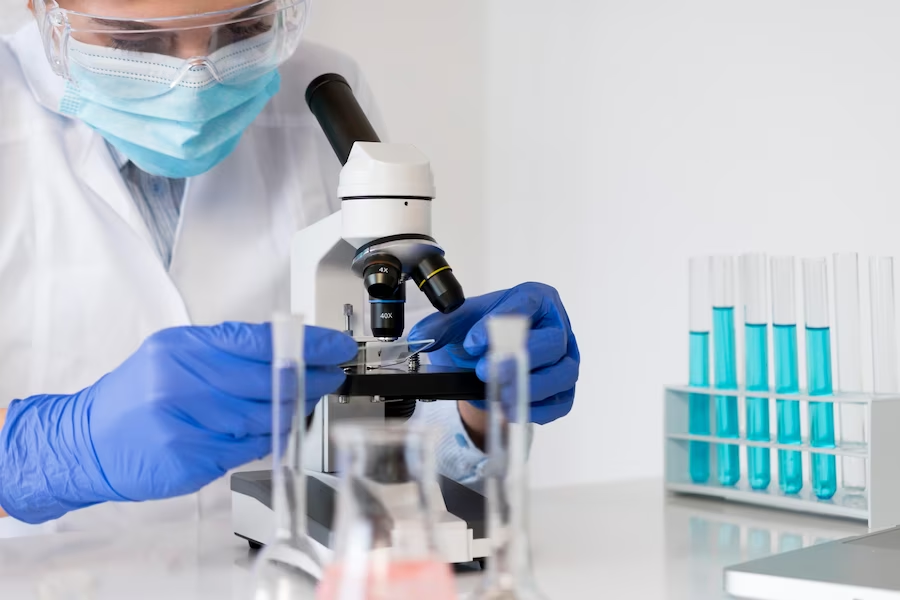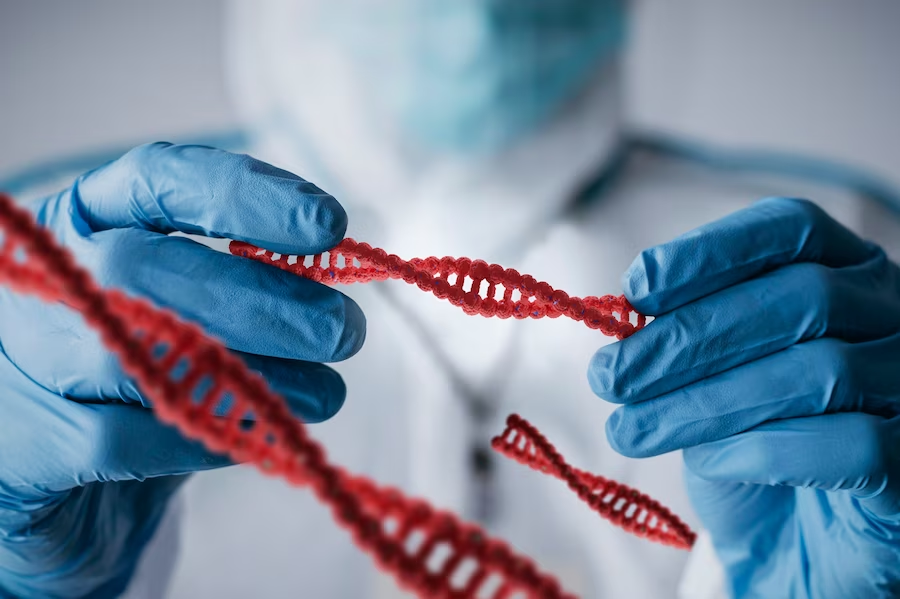In the realm of life’s mysteries, DNA stands as an extraordinary molecule, carrying the genetic code that governs the existence of all living organisms. Understanding its structure, function, and inheritance process allows us to trace back the ancestry of all living beings with surprising precision. Join us on a journey to unravel the intricate secrets of DNA, exploring its double helix structure, the role of nucleotides, and the fascinating world of chromosomes.
At the heart of DNA’s complexity lies its captivating double helix structure, akin to a gracefully twisted ladder. This elegant architecture was first unveiled by the brilliant minds of James Watson and Francis Crick in 1953, a momentous discovery that reshaped the field of genetics forever.
Nucleotides: The Building Blocks
Imagine DNA as a symphony composed of nucleotides, the fundamental building blocks that form the backbone of this miraculous molecule. Each nucleotide comprises three essential components:
- Sugar: Deoxyribose, a five-carbon sugar, serves as the backbone’s spine, lending stability to the DNA structure;
- Phosphate Group: Phosphates link the nucleotides together, creating the strong, resilient bonds that hold DNA’s helical structure intact;
- Nitrogen Base: A mesmerizing array of nitrogenous bases adorns each nucleotide, adding the symphonic variety that dictates the genetic code. Four distinct bases orchestrate the genetic language: Adenine (A), Thymine (T), Guanine (G), and Cytosine (C).
Base Pairs: The Genetic Rungs
As we traverse the enchanting helical path of DNA, we encounter the harmonious symphony of base pairs. The base pairs are the genetic rungs, intricately woven to establish the sequence of genetic instructions. This dance of bases follows a strict code: Adenine (A) always pairs with Thymine (T), and Guanine (G) elegantly binds with Cytosine (C). This dance between complementary bases ensures DNA’s remarkable stability and fidelity during replication.
Chromosomes: The Envoys of DNA
Intriguingly, the wonder of DNA extends beyond its microscopic realm to the macroscopic world of chromosomes. Chromosomes are the tangible manifestation of DNA, serving as carriers of the genetic blueprint. Within the intricate dance of life, they play a vital role in transmitting genetic information from one generation to the next.
Number of Chromosomes
Let us venture into the human genome, where 23 pairs of chromosomes enchant us with their complexity. This marvel brings the total chromosome count to an awe-inspiring 46, ingeniously divided between maternal and paternal contributions.
Autosomes: The Symphony of Non-Sex Determinants
Among the 46 chromosomes, 22 pairs of autosomes guide the functioning of our bodies, intricately weaving the traits that make each individual unique. These autosomes are the conductors of life’s symphony, orchestrating various traits such as eye color, height, and personality.
Sex Chromosomes: The Orchestra of Gender
Amidst the symphonic arrangement of chromosomes, a distinguished pair takes center stage, the heralds of our gender identity. The sex chromosomes, affectionately known as X and Y, determine whether we journey through life as male or female. XX graces the stage for females, while XY commands the spotlight for males, epitomizing the beautiful diversity of life.
Tracing the Ancestral Melody of DNA
The enchantment of DNA transcends time, allowing us to trace our ancestral roots far beyond our comprehension. Through the power of DNA sequencing and genealogy, we can explore our connections to distant relatives, uncovering the echoes of our heritage etched within the very core of our being.
Inheritance Patterns

The inheritance pattern is essential for calculating how many generations back 1 percent of DNA can be traced. Key concepts include:
Mendelian Inheritance
The Dance of Dominance and Recessiveness Mendelian Inheritance, named after the renowned biologist Gregor Mendel, is a fundamental concept in genetics. It governs the transmission of traits from parents to their offspring through dominant and recessive alleles. The following table illustrates the basic principles of Mendelian Inheritance:
| Trait | Dominant Allele | Recessive Allele |
|---|---|---|
| Eye Color | Brown (B) | Blue (b) |
| Hair Texture | Curly (C) | Straight (c) |
| Tongue Rolling | Yes (T) | No (t) |
When an individual inherits two identical alleles for a particular trait (e.g., BB or bb), they express that trait. Conversely, if they inherit two different alleles (e.g., Bb), the dominant allele is expressed, and the recessive allele remains hidden but can be passed on to future generations.

Recombination
The Genetic Shuffle during Meiosis Recombination is nature’s way of ensuring genetic diversity and uniqueness among offspring. It occurs during the process of meiosis, where chromosomes exchange segments of genetic material. This genetic shuffle gives rise to an endless array of combinations, making each individual genetically distinct. The concept of recombination can be visualized using the following diagram:
In this example, the offspring inherits one chromosome from each parent. During recombination, segments of genetic material swap between the corresponding chromosomes, creating a new combination of alleles in the offspring.
Mitochondrial DNA (mtDNA)
Tracing the Maternal Lineage Mitochondrial DNA (mtDNA) is a unique and captivating component of our inheritance patterns. Unlike nuclear DNA, which combines genetic material from both parents, mtDNA is inherited solely from the mother. This uniparental inheritance allows us to trace our maternal lineage back through countless generations. The following bullet list outlines key features of mtDNA inheritance:
- mtDNA is present in the mitochondria, the energy-producing organelles within cells;
- Sperm cells do not contribute mitochondria to the offspring, so only the mother’s mtDNA is passed on;
- mtDNA mutations occur at a relatively constant rate, making it a valuable tool for studying human evolutionary history.
Generations and DNA: Tracing Back 1 Percent
To understand how many generations back 1 percent of DNA can be traced, we must delve into how DNA inheritance works over multiple generations.
DNA Dilution Over Generations
The Vanishing Threads of Ancestry As generations pass, the vibrant threads of DNA that connect us to our ancestors begin to thin out, creating a fascinating cascade of dilution. Each successive generation inherits only a portion of the genetic material from their ancestors. The following table showcases the progressive dilution of DNA over generations:
| Generation | DNA Percentage |
|---|---|
| Parents | 50% |
| Grandparents | 25% |
| 2nd Great-Grandparents | 6.25% |
| 3rd Great-Grandparents | 3.125% |
| 4th Great-Grandparents | 1.5625% |
This dilution continues as we trace back through the generations, with each branch of the family tree contributing less and less DNA to the present generation.
Limitations and Considerations
Unraveling the Genetic Complexity The journey of tracing DNA through generations is a riveting one, but it comes with intriguing complexities that challenge our understanding. Let’s explore some of the limitations and considerations that add layers of depth to this enigmatic puzzle:
- Incomplete Dominance: Genetic traits don’t always follow the predictable patterns of dominance and recessiveness. In some cases, genes may exhibit incomplete dominance, where neither allele is fully expressed, resulting in a blending of traits. This phenomenon can lead to genes skipping generations, making tracing more challenging;
- Genetic Drift: As time marches on, populations undergo genetic drift, a mysterious phenomenon that introduces random changes in allele frequencies. The intricacies of genetic drift can cause certain alleles to become more or less prevalent over time, further complicating the task of tracing DNA back through generations;
- Mutation: Nature loves surprises, and DNA is no exception. Random mutations can occur in DNA, generating new alleles or modifying existing ones. These mutations can lead to variations in traits not directly inherited from ancestors, adding an exciting layer of unpredictability to our genetic heritage.
Commercial DNA Tests: Tools and Techniques

In the modern era of genomics, commercial DNA tests have revolutionized the way we explore our heritage and uncover intriguing insights into our genetic makeup. We will explore the leading players in the industry, the tools and techniques they employ, and the complexities that influence the accuracy and reliability of their results.
Popular DNA Testing Companies
Unveiling the Titans Commercial DNA testing companies have soared in popularity, captivating millions with promises of discovering their ancestral roots and health predispositions. Let’s meet some of the leading players in this exciting domain:
- 23andMe: A trailblazer in the industry, 23andMe offers a comprehensive range of services, including ancestry and health-related genetic testing. Their reports delve into not only genealogical heritage but also provide insights into health risks and carrier status for specific genetic conditions;
- AncestryDNA: A pioneer in genealogical tracing, AncestryDNA specializes in unlocking the secrets of one’s ethnic background and connecting individuals with long-lost relatives. Their vast database facilitates genealogical research and uncovers hidden family ties;
- MyHeritage DNA: Blending ancestry and health testing, MyHeritage DNA provides a holistic approach to genetic exploration. Their services offer users a glimpse into their ancestral origins and health predispositions, empowering them to make informed lifestyle choices.
Accuracy and Reliability
Navigating the Complexity While commercial DNA tests offer a captivating window into our genetic past, it’s essential to recognize the nuances that influence the accuracy and reliability of their findings. The following factors play a crucial role in deciphering the intricacies of these tests:
- Methodology Differences: Each testing company employs distinct methodologies and reference populations to analyze DNA data. As a result, results may vary slightly between different providers. Comparing results from multiple companies can offer a more comprehensive understanding of one’s genetic heritage;
- Sample Size and Quality: The accuracy of DNA test results hinges on the size and quality of the DNA sample provided by the user. Smaller or degraded samples might yield less precise outcomes, emphasizing the importance of following the testing company’s guidelines for sample collection;
- Database Comparisons: Commercial DNA testing companies often compare the user’s DNA to their existing databases to establish connections with relatives and determine ancestral origins. The diversity and size of these databases can impact the specificity of the results, with larger databases providing a broader scope of information.
Conclusion
Tracing 1 percent of DNA back to specific generations is an intricate process that goes beyond simple mathematical calculations. While the pattern of inheritance does follow a logical sequence, many biological factors can influence the accuracy of tracing back a specific percentage of DNA.
Understanding the nature of DNA, how it’s inherited, the tools and techniques used for testing, and the inherent complexities in the process can enrich one’s appreciation for the profound connection between genetics and genealogy.
The topic of tracing back 1 percent DNA, while mathematically straightforward, opens doors to deep biological, genealogical, and even philosophical considerations about human heritage and connection. It invites us to explore our roots, understand our traits, and acknowledge the inherent complexity and wonder of life.
FAQ
Yes, through Y-DNA testing for the paternal line and mtDNA testing for the maternal line.
Yes, privacy and ownership of genetic data can have legal implications. It’s crucial to review the terms and conditions of any DNA testing service.
While it can provide clues, 1 percent DNA might not be enough to definitively identify specific ethnic backgrounds.
